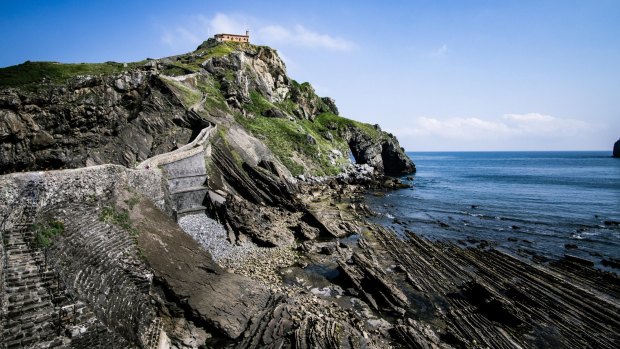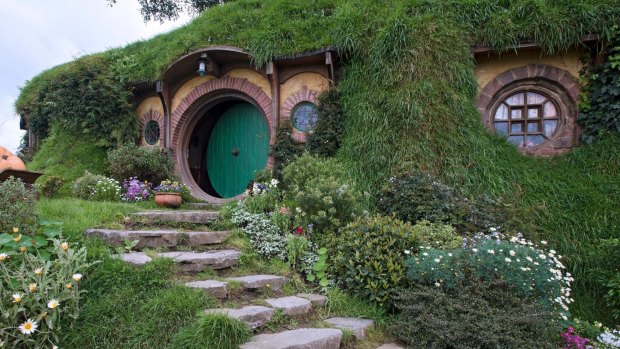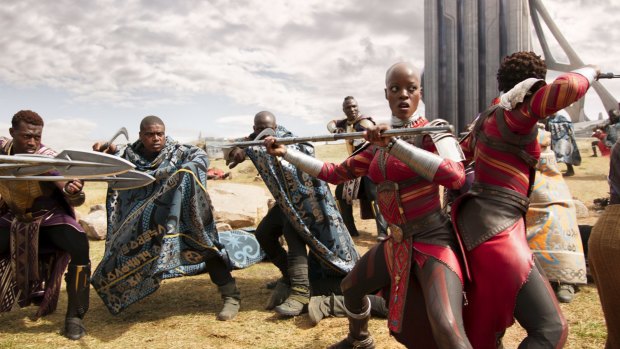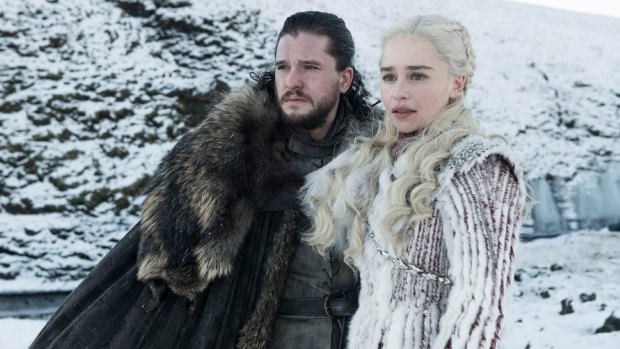This was published 4 years ago
From Game of Thrones' Westeros to Tolkien's Middle-Earth: The seven mythical countries you'll never get to visit
By Ute Junker

The San Juan de Gaztelugatxe Staircase (Dragonstone from Game of Thrones).Credit: Alamy
I racked up a lot of road miles the year I turned six. My family spent several months travelling through Europe and decades on, I still recall not just the mighty monuments, the Eiffel Towers and the Alhambras, but also small random moments, from the shoe shop in the tiny Pyrenees statelet of Andorra where we bought a new pair of sandals for me, to the freshly-caught octopus hanging in the windows of Portuguese restaurants.
Among those striking travel memories, oddly enough, are some that don't actually belong to me. They include a land called Lilliput and its diminutive inhabitants, whom I first encountered via a German-language version of Gulliver's Travels that entertained me during long stretches in the back seat of the car.
It wasn't just the size of Lilliput's inhabitants that caught my imagination. Children's books, after all, are filled with wonders, from teenage wizards to hat-wearing cats and egg-hatching elephants. It was the fact that Lilliput was defined as a real place, with a ruler and capital and customs and religion. It was a country that seemed to belong in the pages of the massive European road atlas that accompanied us on that epic road journey, rather than between the covers of a children's book.

Middle-earth: The Hobbiton Movie Set in New Zealand.Credit: Alamy
Lilliput was, of course, a land invented for adult readers rather than children; in his satirical novel, Jonathan Swift included not just details such as its size and capital city, but also its prophet and its rivalry with its neighbour, Blefuscu. Indeed, Lilliput's diminutive inhabitants had an outsize appetite for conflict, repeatedly going to war with their fellow citizens over the pressing issue of which end of an egg should be cracked first.
As I grew older and journeyed through many more imaginary worlds, I discovered that such belligerence was far from uncommon. Novelists may have no problems conjuring up new worlds entirely different from our own, but it seems they have a hard time imagining a place where people live together harmoniously.
Take the inhabitants of Ishmaelia, the African country which is the setting for Evelyn Waugh's novel Scoop. In this classic satire, an internal crisis in this African country is fanned into a fully-fledged war in order to sell British newspapers. As Waugh tells it, the country of Ishmaelia had escaped colonisation thanks to the penchant of the locals for eating any European adventurers that crossed their borders: "some raw, others stewed and seasoned — according to local usage and the calendar (for the better sort of Ishmaelites have been Christian for many centuries and will not publicly eat human flesh, uncooked, in Lent, without special and costly dispensation from their bishop)."

Black Panther director Ryan Coogler says he based aspects of Wakanda on the southern African country of Lesotho.
It was not only the locals' culinary habits that allowed Ishmaelia to escape the notice of the wider world for so long; Waugh also noted that European explorers were deterred by the inhospitable terrain found along its borders, which included "desert, forest, and swamp, frequented by furious nomads". Today's imaginary countries have more high-tech methods of protecting their frontiers. The East African republic of Wakanda, as featured in the Black Panther movie (based on the Marvel comic book), uses an advanced holographic projection to conceal the country's technologically advanced civilisation and convince the world that it is actually a nation of poor farmers.
As often happens in movies, the production team drew on real-life models to help create their fictional country. Director Ryan Coogler says he based aspects of Wakanda on Lesotho, a southern African kingdom that resisted the Zulus and the Boers, while the Xhosa language does double duty as the language of Wakanda.
Similarly, the team that worked with director Wes Anderson to create the mythical Republic of Zubrowka - the backdrop for his film, The Grand Hotel Budapest – took their inspiration from the Czech spa town of Karlovy Var. From its pastel-painted buildings to its funicular, many of Karlovy Var's most recognisable features appear in the film.

Emilia Clarke and Kit Harington in Game of Thrones.Credit: Alamy
The pocket-sized, pear-producing principality of Genovia, the setting of the Princess Diaries films in which an American teenager suddenly discovered she is the heir to a European kingdom, is also clearly modelled on a real-world counterpart, in this case the Principality of Monaco. Visit Genovia's website (yes, it has one; hats off to the studio's marketing department for that nice touch) and you will read about its Cote d'Azur location, its white sand beaches, turquoise waters and sun-filled skies.
For some readers, having an approximate geographical location for an imaginary destination makes the place feel more real. Gulliver even shares the co-ordinates for each of his impossible islands. True, the locations tended to be outrageously inaccurate; Lilliput, for instance, was identified as sitting between Tasmania and Sumatra, in a spot that is actually covered by the Australian continent. But then, isn't this kind of muddled geography exactly what you would expect from a mariner who got shipwrecked as often as Gulliver did?
Personally, I lean the other way. My favourite imaginary destinations are those that are allowed to float free of reality. I love the boldness of an author who conjures up not just a new country, but an entire world. Few are better at this than JRR Tolkien, who invented not just a history for his Middle-earth, but also a complex geography, complete with formidable ranges like the Misty Mountains, barren landscapes like Morgul Vale and enchanting retreats like the Elvish city of Rivendell.
Tolkien not only gives his readers fascinating destinations to explore; he also provides them with entertaining travel companions. His characters are constantly on their way somewhere, and we see Middle-earth world not just through Tolkien's eyes but also those of his characters. While Tolkien paints a vivid picture of the forbidding woods of Fangorn, its ancient trees laden with ragged leaves and trailing gigantic beards of lichen, the woods are made more memorable by the observations of the hobbits passing through. Pippin, for one, finds it all frightfully untidy. "I can't imagine what spring would look like here, if it ever comes; still less a spring-cleaning," he says.
I am not the only one who prefers to explore imaginary worlds through books rather than through film. Movie directors can marshal incredible resources to produce their visions - director Peter Jackson had literally hundreds of people on his crew for the Lord of the Rings and Hobbit trilogies – but movie sets are just that, a backdrop to the action. It is only in books that we can actually experience new lands with all of our senses, just as the characters do.
That is one of the reasons that Game of Thrones books became such as global hit, spawning the TV series that is now in its final season. Creator George R.R. Martin is in many ways a successor to Tolkien; as his restless characters traipse through the seven kingdoms of Westeros and beyond, we see these brave new worlds through their eyes. It is no accident that the opening credits to the TV series lead viewers across a map of Westeros; these stories cannot be separated from their settings.
Those vividly-drawn destinations range from the fertile lands of The Vale to the forbidding castle of Dragonstone and the Free City of Braavos, where hundreds of tiny islands are connected by stone bridges and watched over by the colossal statue of the Titan of Braavos. Like Ishmaelia and Wakanda, Braavos is another place that was for years hidden from the scrutiny of the outside world, although its back story is very different. Braavos' founders, escaped slaves, deliberately built their new home in a distant, fog-shrouded lagoon and kept the city's existence a secret for many years.
Our guide to many of these places is Tyrion Lannister - dwarf, father-murderer, and one of the few characters who travels out of curiosity as well as out of necessity – but minor characters are also given the opportunity to share their impressions. Among the many depictions of the sun-baked kingdom of Dorne, perhaps the most trenchant summary is given to the captain of the guards, Areo Hotah. Sounding like a traveller disappointed with his package holiday, Hotah grumbles that, "Dornish women were lewd, Dornish wine was sour, and Dornish food was full of queer hot spices. And the Dornish sun was hotter than the pale, wan sun of Norvos, glaring down from a blue sky day after day." Even imaginary worlds, it seems, can't please everyone all of the time.
Sign up for the Traveller Deals newsletter
Get exclusive travel deals delivered straight to your inbox. Sign up now.